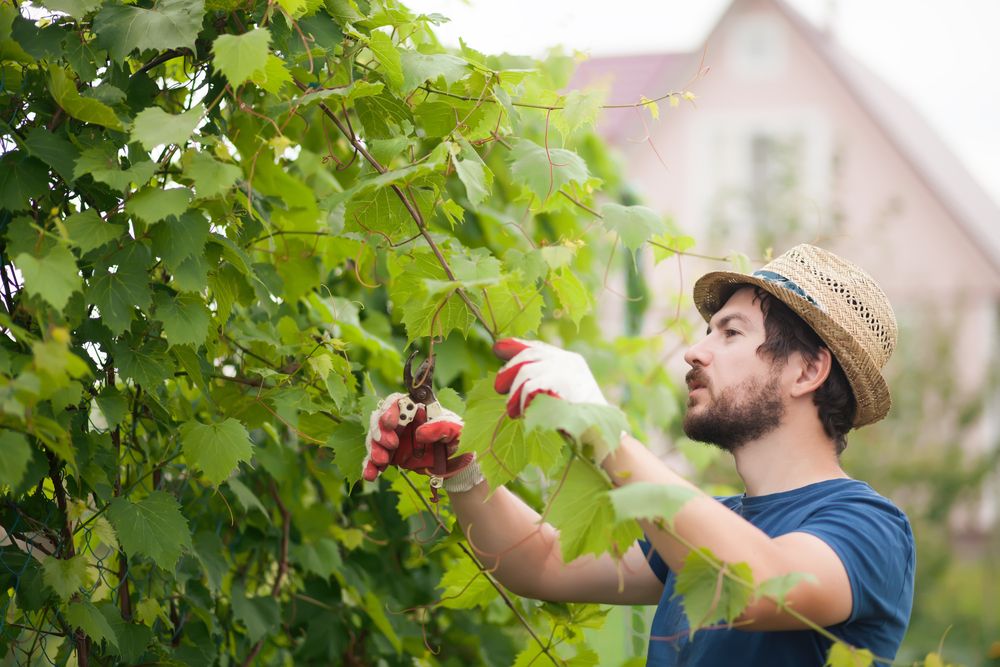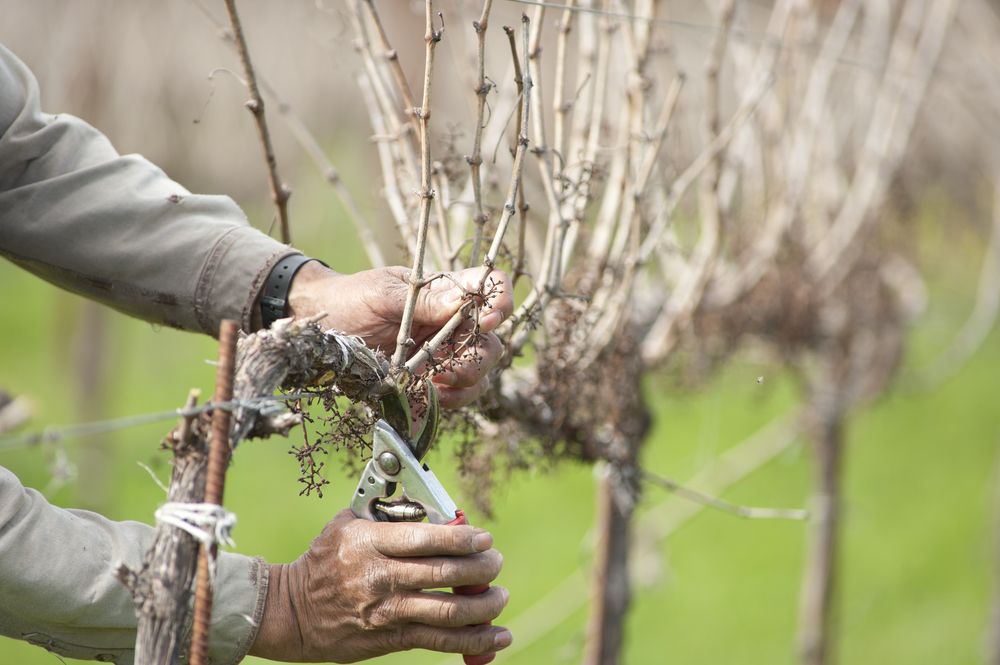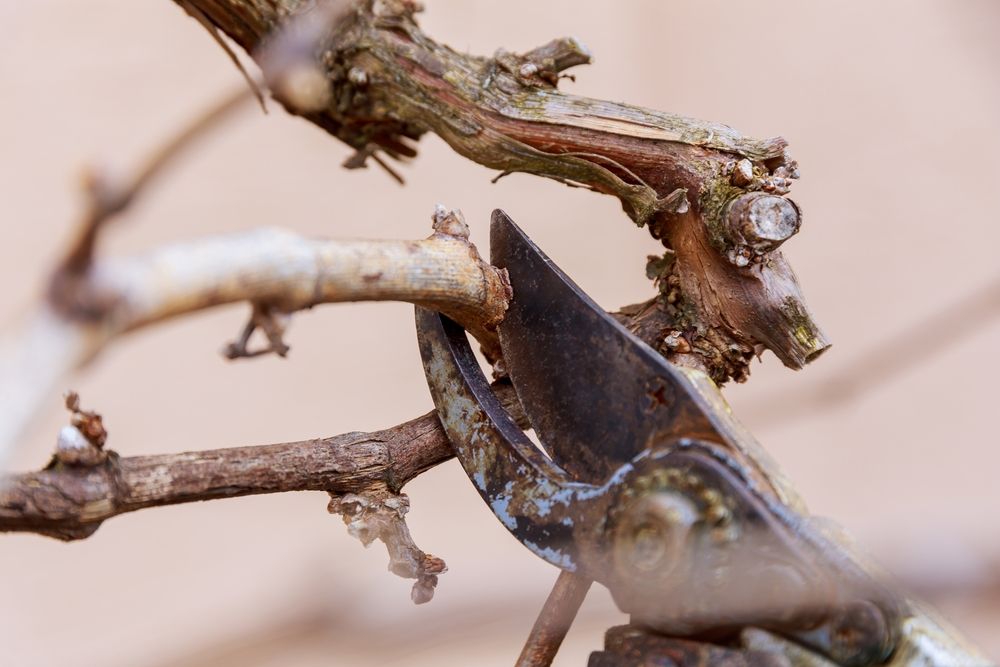
Pruning Grape Vines in Fall: Essential Steps for a Better Harvest
Published: 21/11/2023 | Updated: 28/12/2023


Imagine the satisfaction of harvesting plump, juicy grapes from your backyard, knowing that your diligent efforts in pruning grape vines in fall have paid off. But how can you ensure a better harvest through proper pruning techniques? In this blog post, we will explore the importance of pruning grapevines and share tips to help you achieve a bountiful harvest.
Key Takeaways
-
Fall pruning of grapevines is essential for a successful harvest and should be done during the dormant season.
-
Proper techniques, such as distinguishing between fruiting canes and non-fruiting wood, must be employed to ensure vine health & productivity.
-
Common mistakes like over-pruning or improper timing should be avoided to maintain optimal vine health & yield.

Fall Pruning: Why It Matters
Fall pruning is a vital practice for grapevines, ensuring their health and vigor while promoting fruit quality and productivity. Unpruned or improperly pruned vines can result in excessive foliage, which can negatively impact the quality and quantity of the harvest. Moreover, fall pruning helps regulate the growth and shape of the vines, ensuring adequate air circulation and sunlight exposure for the grape clusters, which facilitates better fruit development and ripening.
Maintaining a balance between vegetative growth and fruit production through fall pruning significantly contributes to grape canopy management. Furthermore, the 30+10+10 balanced pruning system is employed to calculate how many buds are to be preserved on the vine based on the weight of one-year-old wood pruned off, ensuring a better harvest.
Advantages of Fall Pruning
Fall pruning offers several advantages for grapevines. It helps maintain the potential of the grapevine to yield a good quality crop while developing a beneficial vine structure. Pruning in the fall also keeps the vines at a manageable size and shape, improving the quality of the fruit, and promoting bud break in the spring, leading to a healthier and more productive vine.
Increased sunlight exposure is another advantage of fall pruning, as removing lower leaves surrounding the grape bunches before harvest allows for enhanced sun exposure and ripening of the grapes. Pruning in the fall also encourages the growth of fruitful canes that were exposed to light during the growing season, resulting in an improved harvest.
Timing for Fall Pruning
The optimal time for fall pruning is during the dormant season, once the leaves have dropped and before winter’s onset. Pruning grapevines after winter sets in may lead to premature breaking of dormancy, making them vulnerable to freeze injury. It is therefore advisable to prune grapevines during the springtime to prevent any harm from late winter frost.
The climate and region can also affect the timing for the fall pruning of grapevines. In regions with temperate and semiarid climates, global warming is hastening grapevine ripening, increasing must pH, and influencing the timing of harvest. In tropical countries, grapevines are evergreen and are pruned while they are actively growing. Moreover, weather conditions such as rain and wind can transport microbes that can damage the vines, affecting the timing of fall pruning.

Proper Techniques for Pruning Grape Vines in Fall
Applying proper pruning techniques is key to the health and productivity of your grapevines. These techniques involve identifying fruiting canes and non-fruiting wood, choosing between cane and spur pruning, and promoting new growth. By following these guidelines, you can maintain the overall health and vigor of your grapevines while ensuring a bountiful harvest.
Avoiding common fall pruning mistakes like over-pruning, inadequate pruning, and improper timing is crucial. Being mindful of these mistakes and following proper pruning techniques can help ensure that your grapevines remain healthy and productive.
Identifying Fruiting Canes and Non-Fruiting Wood
Fruiting canes are the more recent canes that yield fruit clusters and are pruned back to two-bud spurs, while non-fruiting wood refers to the older canes that do not bear fruit and are usually pruned or eliminated during pruning. To identify fruiting canes in grapevines, you can mark the short and long-pruned canes in different ways, such as by tying something to them loosely or selecting well-matured round canes with a diameter larger than several two pencils.
Non-fruiting wood in grapevines can be identified by its distinctive appearance. It may appear darker, less healthy, and damaged in comparison to the fruiting canes. Furthermore, non-fruiting wood may have buds that did not grow out or develop on green shoots as axillary buds. It is imperative to inspect the canes and buds for winter damage before pruning.
Cane Pruning vs. Spur Pruning
Cane pruning and spur pruning are two common methods for pruning grapevines, each with its advantages and disadvantages. Cane pruning involves pruning annually to eliminate all growth apart from two entire canes from the prior growing season and two other canes each trimmed back to a spur. On the other hand, spur pruning involves pruning back the newer fruiting canes to two-bud spurs. Cane pruning requires fewer cuts but takes longer, while spur pruning is quicker but requires more cuts.
The choice between cane and spur pruning depends on the grape variety and the desired vine structure. It is recommended that one-year-old canes grown along the cordon be pruned. These canes can be pruned back to either three- to five-node spurs as fruiting wood or one-node renewal spurs as vegetative wood.
Ultimately, selecting the appropriate pruning method based on your grapevine’s needs will ensure a healthy and productive vine.
Renewal Spurs and New Growth
Renewal spurs are essential for promoting new growth and maintaining a healthy vine structure. They are canes that are pruned back to one or two buds to generate new vegetative shoots for the following year’s fruiting wood. To identify and cultivate renewal spurs on grapevines, one should follow these steps:
-
Select one or two spur canes on either side of the trunk.
-
Prune back the selected canes to a two-bud spur.
-
These renewal spurs will provide additional canes for future growth and training.
Encouraging new growth plays a key role in securing a better harvest. By pruning back to renewal spurs, you can guarantee consistent production, and high fruit quality, and facilitate the regulation of the size and shape of the vines. This approach ensures a supply of high-quality fruit for consumers.
Tips for Pruning Neglected Vines
Inheriting a vineyard or neglecting your grapevines for a few seasons is not the end of the world. Pruning neglected vines is achievable by assessing vine health and structure, removing excess growth, and encouraging new fruiting canes. With a little knowledge and effort, you can revitalize your grapevines and enjoy a bountiful harvest.
Don’t let neglected vines intimidate you. By following the tips provided in this blog post, you can transform your vineyard into a thriving garden, producing high-quality grapes for years to come.
Assessing Vine Health and Structure
Assessing the health and structure of the vines is an important step before you start pruning neglected grapevines. Look for indications of a healthy grapevine, such as living buds that start to swell in the early spring, vigorous growth, no visible signs of nutrient deficiencies, and no symptoms of disease or pest damage. Additionally, evaluate the vine’s structure, ensuring it has a robust trunk, well-developed canes and shoots, and a vigorous root system.
Inspecting the vine's health and structure allows you to determine the best course of action for pruning. By identifying any potential issues, you can address them accordingly and ensure the continued health and productivity of your grapevines.
Removing Excess Growth
Eliminating excess growth from neglected vines is key to enhancing sunlight exposure and encouraging new growth. Excess growth can result in competition for soil resources, decreased vegetative growth, and increased susceptibility to disease and pest infestation. By eliminating unnecessary growth, you can enhance sun exposure and ripening of the grapes, as well as improve overall vine health in terms of sunlight exposure.
To remove excess growth, use tools such as hand shears, lopping shears, a saw, and gloves. Additionally, sanitize the vineyard by removing infected mummies, twigs, or shoots, and control disease by removing infected plant material and applying preventative treatments. By clearing away excess growth, you can create a healthier environment for your grapevines to thrive.
Encouraging New Fruiting Canes
To encourage new fruiting canes on neglected vines, follow these steps:
-
Select strong, healthy canes.
-
Prune the canes appropriately.
-
Fruiting canes are essential for bearing fruit, as grapes are produced on the green shoots that emerge from one-year-old canes.
-
By pruning the vines carefully, you can stimulate the growth of new fruiting canes and improve your harvest.
Don’t be disheartened by neglected vines. With proper pruning and care, you can encourage new fruiting canes and revitalize your grapevine, ensuring a fruitful harvest and a thriving vineyard.
Common Fall Pruning Mistakes to Avoid
Embarking on your fall pruning journey requires awareness of common mistakes to sidestep. Over-pruning, inadequate pruning, and improper timing can all have negative effects on the health and productivity of your grapevines. By being mindful of these mistakes and adhering to proper pruning techniques, you can ensure the continued success of your vineyard.
Let’s delve deeper into these common fall pruning mistakes and learn how to prevent them, ensuring the health and productivity of your grapevines.
Over-Pruning
Over-pruning can have negative effects on grapevines, including:
-
Weakening the vines and reducing fruit production
-
Impeding airflow and light penetration, leading to poor fruit maturation and increased susceptibility to disease
-
Decline in overall vine health
-
Decrease in fruit production and yield
Avoiding over-pruning when pruning grapevines in the fall requires waiting until the threat of spring freezes has passed. To properly prune grape vines, pruning should be conducted after leaf fall in the late fall or winter, and all 1-year-old wood should be removed. This process helps to effectively prune grapes and maintain the health of the grape vines, making pruning grapes an essential task for vineyard management.
Compared to light pruning, heavier dormant pruning is advised for adequate fruiting.
Inadequate Pruning
Inadequate pruning can result in several issues for grapevines, such as overcrowded vines, poor fruit quality, and diminished vegetative growth. Leaving too many buds or not pruning enough can result in under-pruned vines, which can lead to poor fruit yield and low-quality fruit.
Pruning a sufficient number of canes—typically 40 to 50 buds for an average-sized grapevine—helps prevent inadequate pruning. Additionally, select canes that are slightly thicker than one’s thumb to ensure proper pruning. By avoiding inadequate pruning, you can maintain the health and productivity of your grapevines.
Improper Timing
Improper timing when pruning grapevines can expose the vines to harsh winter conditions and reduce their overall health. Pruning too early in the fall can impede the vine’s ability to enter a dormant state and increase the risk of cold damage. It is important to prune grapevines during the correct season, such as in spring, to avoid potential risks.
Paying attention to the timing of your pruning can help maintain the health and productivity of your grapevines, contributing to a plentiful harvest.
Training Systems for Grape Vines
For efficient fruit production, grapevines require training systems that establish structure and support. The choice of training system depends on the grape variety, the desired vine structure, and the specific needs of your vineyard. By understanding the different training systems available, you can choose the most suitable method for your grapevines and ensure their continued success.
This section will delve into the differences between single-wire and double-wire systems and also cover the popular Vertical Shoot Positioning (VSP) method.
Single Wire vs. Double Wire Systems
Single-wire and double-wire systems are common training methods for grapevines, each with its advantages and disadvantages. A single-wire system involves a single strand of wire to support the vines, usually situated at a height of 5 to 6 feet above the ground.
In contrast, a double-wire system uses two wires to support and train the vines, with one wire situated at the bottom for training and irrigation purposes, and the other wire situated at the top for canopy support.
The choice between single-wire and double-wire systems depends on your specific needs and the grape variety you are cultivating. Single-wire systems are less costly to construct but may provide less vine support.
Double wire systems offer enhanced support for the vines, improved air circulation and sunlight penetration, and increased grape yield, but may have higher installation costs and increased labor and maintenance requirements.
Vertical Shoot Positioning (VSP)
Vertical Shoot Positioning (VSP) is a popular training system that promotes sunlight exposure and efficient fruit production. In VSP, the shoots are trained to grow in a vertical position with the aid of multiple catch wires. This system is primarily employed for upright-growing grape cultivars to enhance exposure and regulate canopy growth, with the grape clusters left exposed below the trained shoots.
VSP offers several benefits, such as improved sun exposure and airflow, as well as more efficient farming operations, including leaf removal, shoot removal, and cluster thinning, which further enhance fruit quality and yield. By adopting the VSP method, you can optimize the growth and productivity of your grapevines.
Prune Your Way to Lush Garden
Proper fall pruning is essential for maintaining the health and productivity of your grapevines. By understanding the importance of fall pruning, employing proper pruning techniques, avoiding common mistakes, and selecting the appropriate training system, you can ensure a thriving vineyard and a bountiful harvest. Now it’s time to put these tips into action and reap the rewards of your hard work. Now, embark on your pruning journey with confidence. For more guidance or expert advice, reach out to ShrubHub's friendly team of landscape specialists. Get ready to witness your grapevines flourish and enjoy the fruits of your labor.
Frequently Asked Questions
Can you trim grape vines in the fall?
Yes, grapevines can be trimmed in the fall after leaves have dropped. Pruning during the dormant season is essential for a healthy grapevine.
How do you prepare grape vines for winter?
Prepare grape vines for winter by pruning them in the fall after leaves have dropped and vines have gone dormant, releasing them and gently bending them onto the ground, then completely burying them with dirt, straw, and snow.
How far back should I cut my grapevine?
To maintain a healthy and productive grapevine, it is best to prune it yearly in late February or March when the risk of spring freezes has passed. Select two to four new fruiting canes per vine and cut back each to leave about 15 buds per cane. Pruning should be done once the leaves have all fallen off and the vine is in a dormant state.
How can I identify fruiting canes and non-fruiting wood in grapevines?
To identify fruiting canes and non-fruiting wood in grapevines, inspect the canes and buds for winter damage and select well-matured round canes with a diameter larger than a number two pencil.
What are the differences between cane pruning and spur pruning?
Cane pruning involves removing all growth apart from two canes from the previous season and trimming two other canes to a spur, while spur pruning involves pruning back the newer fruiting canes to two-bud spurs.


